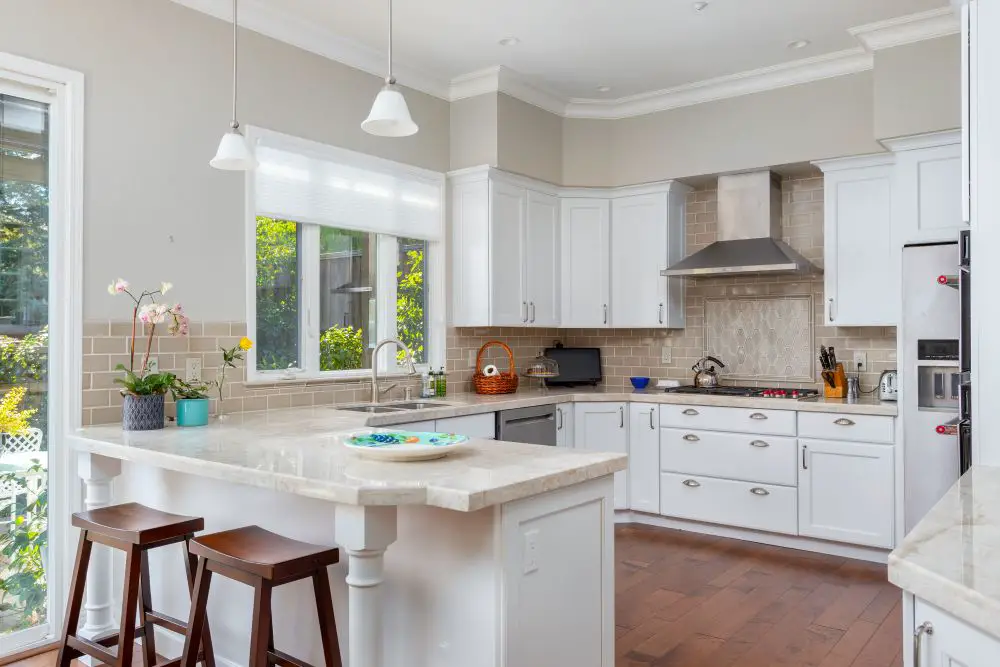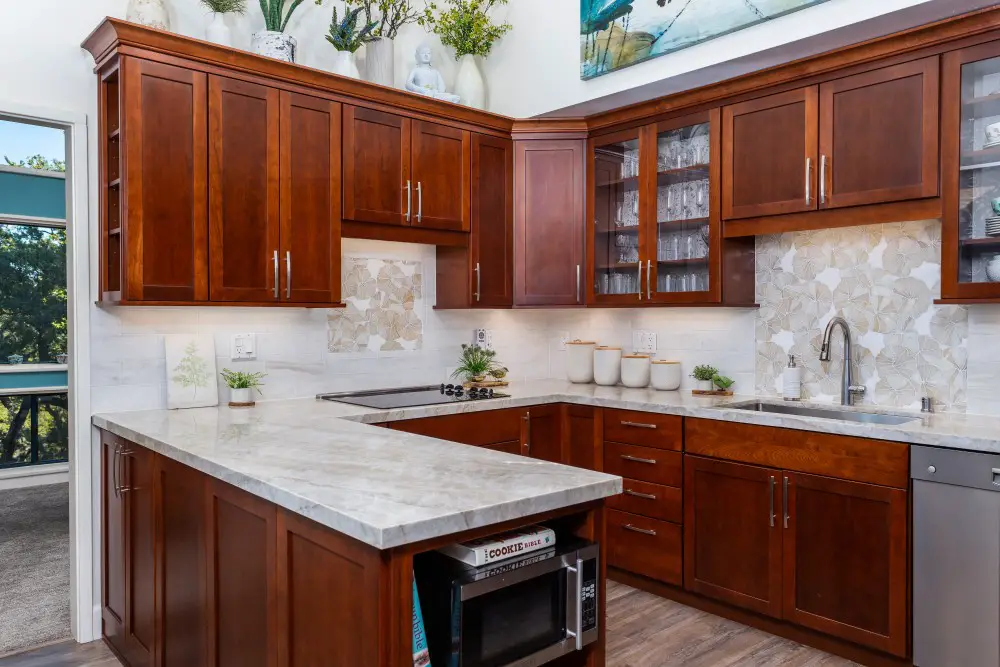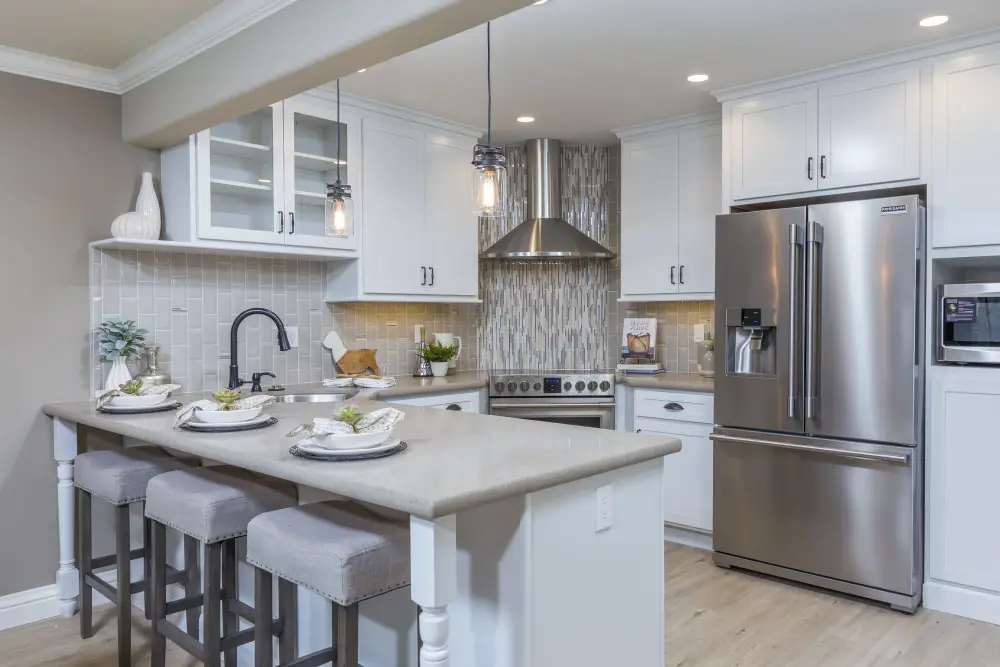By using our website, you agree to the use of cookies as described in our Cookie Policy
The Boss’s Daughter
Peninsulas in the Kitchen: The Perfect Blend of Style and Functionality

Peninsulas in the Kitchen: The Perfect Blend of Style and Functionality
Key Takeaways
-
A kitchen peninsula adds counter space, seating, and storage—without requiring the footprint of an island.
-
Ideal for open-concept layouts, peninsulas create a natural boundary between kitchen and living spaces.
-
They typically cost less than islands, using fewer materials and less labor.
-
Perfect for small to mid-size kitchens or layouts with one main entry, like many Rossmoor units.
-
Design upgrades that work beautifully include waterfall counters, two-tone cabinetry, open shelving, pendant lighting, and built-in appliances.
“This peninsula steals the show with its seamless stone edge and soft coastal tones—practical, pretty, and perfect for gathering.”
If you’re dreaming of a kitchen remodel (or just love geeking out over interior design—same here!), let’s talk about one of the most underrated heroes of kitchen layouts: the peninsula.
You’ve probably heard endless praise for kitchen islands, but what about their slightly more grounded cousin? Kitchen peninsulas offer the best of both worlds—maximized function, natural flow, and built-in charm—without consuming as much floor space as an island.
What Is a Kitchen Peninsula?
A kitchen peninsula is essentially an island that remains connected on one side. It extends from your cabinetry or wall, creating an “L” or “U” shape that defines the kitchen while keeping it open.
Think of it as a bridge between the kitchen and the rest of your home: one side for cooking, the other for connection.
(For a deeper dive into kitchen layout logic, check out Understanding Kitchen Zones: A Guide to an Efficient Cooking Space.)
Peninsula vs. Island: What’s the Difference?
While islands often grab the spotlight, peninsulas quietly outperform them in practicality—especially in real homes, not just glossy magazine spreads.
Here’s why peninsulas deserve more love:
1. More Counter Space, Less Floor Space
If your kitchen can’t accommodate a freestanding island, a peninsula offers generous workspace without disrupting the traffic flow. Standard clearance on the working side should be 36–42 inches—enough for prepping, baking, or serving without feeling boxed in.
2. Extra Seating Without the Bulk
A peninsula provides built-in bar seating. Plan 24 inches of width per stool and 12–15 inches of countertop overhang for comfort. It’s perfect for quick breakfasts, homework sessions, or Friday-night wine chats.
3. Defines Open-Concept Spaces
In open layouts, a peninsula subtly separates kitchen and living zones, keeping conversations connected but cooking chaos contained.
4. Built-In Storage Opportunities
Because it ties into your cabinetry, a peninsula can include deep drawers, tray dividers, or even a hidden trash pull-out—storage most islands can’t match without extra framing.
5. Budget-Friendly Brilliance
Peninsulas typically cost 15–25 percent less than comparable islands. Fewer finished sides, simpler electrical runs, and shared cabinetry make them a smart investment for homeowners who want function and flair without overspending.
(Need budgeting inspiration? Read Budget-Friendly Remodeling: Big Style, Smart Spending.)
Design Ideas for a Perfect Peninsula
“This waterfall peninsula isn’t just a pretty face—it’s where sleek design meets serious ‘wow’ factor, wrapping the countertop down the sides like it’s showing off (and honestly, it should be).”
Let’s talk details—the part that makes a peninsula yours.
Waterfall Countertops
Waterfall edges extend the slab down both sides for a seamless, sculptural look. They protect cabinet corners and add a touch of modern luxury. I currently have this in my own kitchen, and I’m obsessed—it’s timeless, clean, and elegant.
Two-Tone Cabinetry
Contrast makes everything pop. Pair white upper cabinets with a navy or charcoal peninsula for visual balance and personality.
Open Shelving Ends
Use the outer side of the peninsula for open shelves. It’s perfect for cookbooks, decorative bowls, or wine storage—functional and photogenic.
Statement Lighting
Pendant lighting isn’t just for islands. Hang two or three over your peninsula to highlight the counter and define the zone. Mount them 30–36 inches above the surface for ideal illumination.
Built-In Appliances
Maximize every inch by integrating a microwave drawer, beverage fridge, or pull-out spice rack. It keeps countertops clutter-free and workflow efficient.
(Want to pair your peninsula with the right materials? Explore The Ultimate Guide to Countertop Materials: Pros, Cons, and Costs.)
Space and Seating Guidelines
A few quick rules of thumb from our design team:
| Feature | Recommended Measurement |
|---|---|
| Counter height | 36 inches |
| Stool height | 24–26 inches |
| Overhang depth | 12–15 inches |
| Seating width per person | 24 inches |
| Clearance behind stools | 36 inches minimum |
These guidelines keep your peninsula comfortable and compliant with California building standards.
Cost Overview
Actual cost depends on material and cabinetry choices, but here’s a general snapshot:
| Category | Typical Range (East Bay) | Notes |
|---|---|---|
| Cabinetry + framing | $1,500 – $4,000 | Reuses existing structure or adds base units |
| Countertop fabrication | $2,000 – $5,000 | Varies by material (quartz, granite, marble) |
| Electrical + lighting | $500 – $1,200 | Pendants or outlets for appliances |
| Flooring adjustments | $300 – $800 | Patch or refinish adjacent floors |
| Labor + finish work | $1,000 – $2,500 | Depends on size and finish complexity |
Peninsulas almost always land below the price of a standalone island, making them a great middle ground for remodels under $10 K.
Real Rossmoor Examples
We’ve installed peninsulas in numerous Rossmoor units, where efficient use of space is key.
-
Golden Gate Model: We replaced a wall with a peninsula to create an open-concept kitchen, adding two stools and 5 feet of additional counter space.
-
Sonoma Model: By integrating drawer storage and pendant lighting, the new peninsula created a cozy breakfast spot while visually expanding the galley layout.
(See photos of both projects in our portfolio.)
Is a Peninsula Right for You?
A peninsula makes sense if:
☑ Your kitchen is too small for an island but needs more workspace.
☑ You love open-concept flow but want slight separation.
☑ You crave more storage without expanding your footprint.
☑ You want a stylish, cost-effective remodel feature.
Avoid a peninsula if your kitchen is narrow with multiple doorways—it can restrict movement. Always confirm 36–42 inches of clearance for comfortable circulation.
Planning Your Peninsula: 5 Steps
-
Measure Your Space – Confirm clearances and traffic paths.
-
Decide the Function – Seating, prep, or storage? Design accordingly.
-
Plan Power & Lighting – Include outlets for small appliances and pendant wiring early.
-
Select Finishes – Match or contrast cabinetry, and coordinate countertop thickness (1¼ inch typical).
-
Install & Inspect – Finalize edges, hardware alignment, and surface sealing.

FAQ
Is a peninsula better than an island for a small kitchen?
Yes. Peninsulas add workspace and seating while preserving walkways—ideal for compact layouts.
How much space do I need around a peninsula?
Allow 36–42 inches of clearance on the working side to keep prep and traffic comfortable.
Can I add seating at a peninsula?
Absolutely. Plan 24 inches per seat and 12–15 inches of overhang for knee room.
What can I build into a peninsula?
Base cabinets, drawers, a microwave drawer, trash pull-outs, or even a beverage fridge.
Do peninsulas work in Rossmoor units like Golden Gate or Sonoma?
Yes. These layouts often support a peninsula to improve storage and seating. See examples in our portfolio.
Final Thoughts
Kitchen peninsulas may not get the same fame as islands, but they deliver an incredible balance of form, function, and flexibility. Whether you’re adding seating, carving out a prep zone, or defining an open layout, the peninsula proves you can have style and practicality in one perfect piece.
“When your peninsula has personality—this beauty shows off art, adds counter space, and still manages to be the life of the kitchen party.”
Thinking about adding one to your kitchen?
Contact Toupin Construction to explore ideas, see what fits your floor plan, and discover why so many East Bay homeowners are choosing peninsulas over islands.
‹ Back



Comments